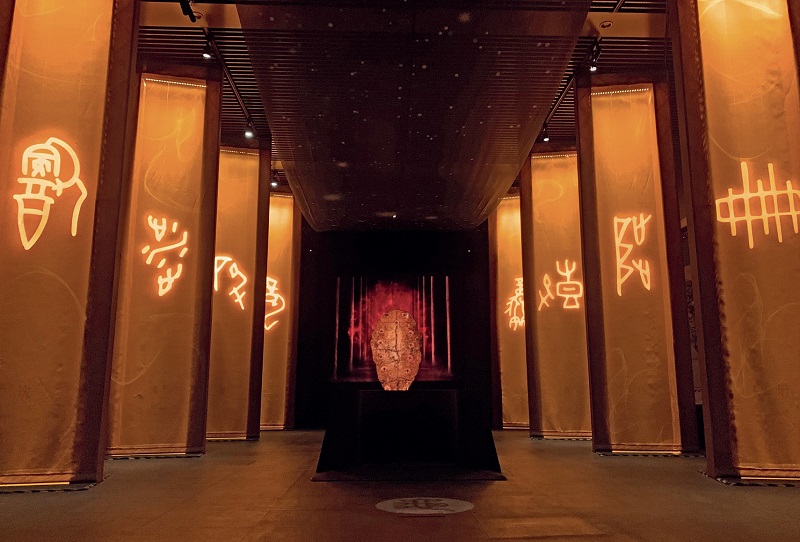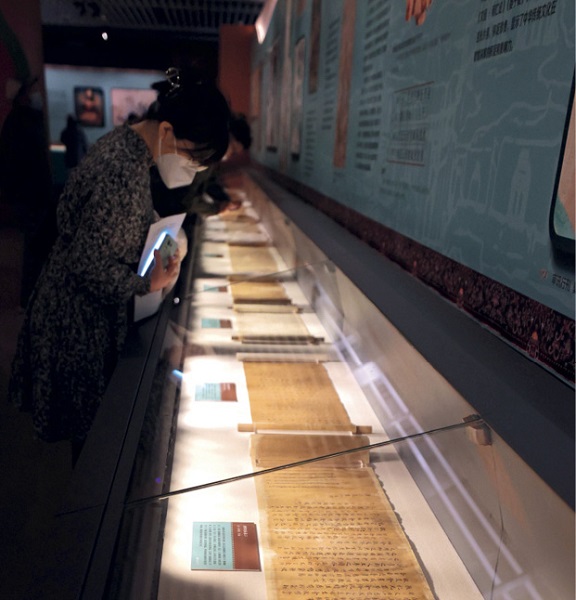Incredible texts from China's ancient past offer a deeper insight into Chinese history, culture, identity, and wisdom.

Oracle bone inscriptions from the Shang Dynasty are among the four significant archaeological discoveries about ancient Chinese texts made at the start of the 20th century.
There were four significant archaeological discoveries about ancient Chinese texts at the start of the 20th century — oracle bone inscriptions from the Shang Dynasty (1600-1100 BC), inscribed bamboo and wooden slips from the Han Dynasty (206 BC- AD 220), documents found in the Dunhuang caves dated between the fourth and 11th century, and the Grand Secretariat archives of the Ming and Qing dynasties (1368-1911). In mid-February this year, an exhibition of these discoveries opened at the National Museum of Classic Books (within National Library of China) in Beijing, putting on public display many treasured objects of this cultural heritage for the first time.
Cultural Lineage
The exhibition consists of four sections that are respectively dedicated to oracle bone inscriptions, Han bamboo and wooden slips unearthed in Juyan, Dunhuang documents, and Ming and Qing archives. These treasured items add up to 382 historical items that span 3,000 years in Chinese civilization.
The oracle bone inscriptions are the earliest Chinese writing scripts. In 1899 Wang Yirong (1845-1900), a Qing official who was also an ephigrapher and calligrapher, identified the scratches on a traditional Chinese medicine material called “dragon bone” as ancient writings. Excavation, collection, and study of these early scripts subsequently began.
These inscriptions dated back to 3,000 years ago extending the recorded history of China by about 1,000 years, and are the firsthand reference for research of late Shang Dynasty (after its capital was moved to Yin in today’s An-yang, Henan Province). They are therefore of immeasurable value to tracing the roots and course of the Chinese civilization, preserving traditional Chinese culture, and reinforcing the solidarity of the Chinese nation.
The other three discoveries are just as anecdotal and monumental. In 1930, a team of Swedish and Chinese scientists unearthed more than 10,000 bamboo and wood slips carved with writings in Juyan, a region of Han frontier outposts at the juncture of today’s Inner Mongolia Autonomous Region and Gansu Province. In 1900, a Taoist Wang Yuanlu (1849-1931) accidentally found a hollow behind the northern wall of the 16th Cave of Dunhuang, which turned out to be a cache full of Buddhist manuscripts, paintings, and other artifacts. In 1921 the cash-strapped Beiyang government sold 8,000 sacks of Ming and Qing archives to a paper store for 4,000 silver coins. Knowing their value, a former Qing official, Luo Zhenyu (1866-1940), who was also an archaeologist and palaeograpist, bought most of these materials. These materials later ended up in the hands of a research institute.
These invaluable cultural treasures have attracted scholars of several generations to study, which has led to a new, deeper understanding of Chinese history and culture. Their research has redefined the significance of the Chinese civilization to human progress.

Some of the documents found in Dunhuang caves dated between the fourth and 11th century are on display at the National Museum of Classic Books in Beijing.
Rare Insight
“This exhibition is the largest show of the ‘four discoveries’ to date. The writing materials — shells, bones, bamboo, wood, and paper — are highly fragile, so the exhibits are rare for the public to see. The exhibition has so far received more than 35,000 visitors,” said Gu Heng, head of the exhibition section of the National Library of China.
This year is the Year of the Rabbit, so a turtle shell bearing the early form of Chinese character for rabbit is of particular interest to many visitors. “It is a plastron segment recording the Shang emperor’s hunting of deer and rabbits. The pictogram of a rabbit gives a vivid description of the animal’s legs and short tail. Many children have taken a liking to it,” Gu said.
Another oracle bone popular among visitors is the one coded 5405, which is the largest and has the most inscriptions in the library’s collection. “Measured 43.5 x 24 cm, oracle bone 5405 carries a message of 218 characters about offering sacrifices to Yin ancestors and mountain gods,” a museum tour guide told her audience.
Many more of the exhibits are of high cultural and historical value in their own right. The bamboo and wood slips unearthed at the ruins of the Golden Pass of Jianshui, a frontier military fortress built more than 2,000 years ago in today’s Gansu Province, are from the collections of the National Library of China and Gansu Jiandu (meaning inscribed bamboo and wood slips) Museum. They are part of the 10,000-plus slips that have been found at the site, and offer a rare insight into the economy, social affairs, legal system, and literature of the Han Dynasty.
A copy of the first volume of Dharmagupta Vinaya, transcribed in the year 417, is the oldest of the Dunhuang documents in the National Library’s collection. It is written in the Beiliang calligraphic style, which was often used in stone carvings of Buddhist manuscripts in Liangzhou (today’s Wuwei City in Gansu) and the regions west of it. Beiliang is a transition between Li (seal) and Kai (regular) script.
Also on display is a replica of the only extant golden canister in which the Qing Emperor Daoguang placed the edict on selection of his heir. Another Qing object that attracts great attention from visitors with young children, is the reproduction of the civilian “golden list,” the name list of people who passed the imperial exam, which gave them the qualification for taking civil positions in the imperial court. In Chinese, the idiom “having your name on the golden list” is often used when wishing a person success in important exams like Gaokao, the national college entrance exam.
Trans-dimensional Collaboration
“A library, a museum, an academy, and archives working together to give an exhibition is like bringing down the barriers between two and three dimensions,” said Cering Doje, a Tibetan student of the Minzu University of China.
Jointly sponsored by the First Historical Archives of China, Dunhuang Academy, National Library of China (National Museum of Classic Books) and Gansu Jiandu Museum, this exhibition marks a successful experiment by pooling resources of different institutions from different regions, to present the best of Chinese cultural heritage.
The exhibition also makes forays into new media platforms to reach more audiences. Its livestreaming event “Curators Exploring the Museum,” for example, garnered more than 2.8 million views on the 5G platform China Media Group Mobile, and its post on Weibo “Interesting China Stories behind Cultural Relics” got 150 million hits.
In addition to its presence on media platforms like China Central Television and Douyin (Chinese version of TikTok), the exhibition provides interactive visitor experience, enhanced by high technologies and multi-media to appeal to young audiences.
“In partnership with BiteDance, we created four VR interactive documentaries about the stories behind some iconic exhibits, by recreating past scenes based on historical records and archaeological finds,” said Gu Heng. VR technology was also employed in producing the immersive experience online program “A Tour of Ancient Documents” and in creating a VR version of the exhibition, added Gu. This has made the event available to more members of the public online and offline, in both 2D and 4D formats.
Meanwhile, through an agreement with Beijing MTR, the National Museum of Classic Books has placed 11 replicas of the “four discoveries” exhibits at a nearby subway station, and put on posters with a QR code for passengers to scan to learn more of the exhibition. This has further extended the reach of the event, opening up new fronts for cultural activities and integrating them closer with people’s everyday life.